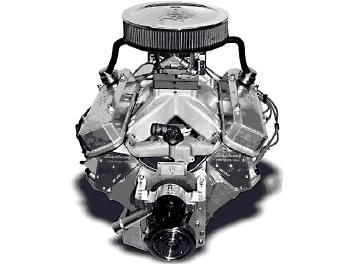Engine Masters Competition
Engine Masters Challenge
SIXTH PLACE FINISH

PONTIAC Peak HP: 659@ 6,200 rpm
Peak TQ: 624.5@ 4,600 rpm
Avg. HP: 523
Avg TQ: 578.6
SCORE: 1101.6
Cubic Inches:467
Cam: Solid Flat Tappet
Fuel: Gasoline - 92 Octane
If there is any more question about the performance potential of the traditional Pontiac engine, these results should provide a clear-cut answer. Saddled with an inline-valve design by the factory and limited by our stern rules structure, the Butlers proved the old-school Poncho can run with the big dogs, and outrun most of them. The street-limited nature of our rules helped level the playing field, and the Butlers took full advantage. Pushing their well-developed crate engine package to its 92-octane limits, the Tennessee-based family of Pontiac engine builders delivered an engine capable of making power in the 645-horse (at peak) range run after run. The ample torque helped raise their average numbers, and fine-tuning upped their score from the Regional competition enough to finish 6th overall.
The addition of Edelbrock's Pontiac cylinder head made the difference, and the Butler's experience in working with the head is obvious. If you're a Pontiac fan and you're looking to kick some butt with a pump-gas Poncho, the results of the Challenge would recommend you make a call to Tennessee. The Butlers are a kind, honest
group of straight shooters, and their aim is true.
-Popular Hotrodding Magazine
Popular Hotrodding Engine Masters Challenge Page
High Performance Pontiac Article
Indeed, the performance of the Butler 467 is impressive when one realizes that very little in the way of testing for the optimum combination was performed. Where some of the other competitors tried as many as 5 other camshafts in their engines, the Butlers were forced by the constraints of time to try only one camshaft, rocker ratio, intake, carb, and one set of headers.
"We built this engine on a Wednesday, broke it in and tested it that Thursday afternoon and carried it to Comp Cams the following Monday for the regional competition, without making any changes, other than timing and jetting," David Butler recalled. "We didn't even change valve lash or spark plug gap. We built this engine just like all of our customers engines and competed with it just like we assembled it the first and only time."
COMMENTS FROM THE BUILDER
We have used this long rod combo for many years and made it readily available (with our initial partnership with Eagle) to the general customer at a very reasonable price with the production of the new cranks. We use these long rods for broad power and durability, especially when using cast cranks and factory blocks.
This contest was a perfect fit to showcase what we build every day. Most of the pieces in this combo are parts that we stock in-house and use in our customers engines. We didn't use any coatings, exotic rotating assembly or valvetrain pieces, high compression that would live only through the dyno pulls, or do things that we wouldn't normally do for a good reliable pump gas, street/strip engine.
Because of this, we had to spend very little time from specing the engine to final tuning. The one piece we did use on this engine that we might not normally use on an engine like this was the BOP belt drive. The nice thing about the belt drive is our ability to change cam timing right on the dyno in just a matter of minutes--very important because of the limited time we have to make changes. Otherwise we would use a traditional timing chain, timing cover, and water pump set up.
-High Performance Pontiac Magazine
High Performance Pontiac's complete article
